Peugeot 207 Dag (2010 year). Manual — part 14

214
06
11
22
11
11
22
33
22
YES
RECEIVING A CALL
An incoming call is announced by a ring and a superimposed display
on the multifunction screen.
Initiate the pairing between the telephone and
the vehicle. This pairing can be initiated from
the vehicle's telephone function menu or via the
telephone's keypad. See steps 1 to 10 on the
previous pages. During the pairing phase, the vehicle
must be stationary with the key in the ignition.
Select the telephone to be connected from the telephone function
menu.
The audio system connects to a newly paired telephone
automatically.
Select the YES tab on the display
using the buttons and confi rm by
pressing OK.
Press the steering mounted control OK to accept
the call.
From the Bluetooth telephone function Audio menu, select Manage
the telephone call then Call, Call list or Directory.
Press the end of the steering mounted control for
more than two seconds to gain access to your
directory.
Or
To dial a number, use your telephone's keypad, with
the vehicle stationary.
MAKING A CALL
BLUETOOTH AUDIO STREAMING
(AVAILABLE DURING THE YEAR)
Wireless transmission of the telephone's music fi les via the audio
equipment. The telephone must be able to manage the appropriate
bluetooth profi les (Profi les A2DP/AVRCP).
* In certain cases, playing of the Audio fi les must be initiated from the
keypad.
** If the telephone supports the function.
Activate the streaming source by
pressing the SOURCE button * . The
tracks to be played can be controlled
as usual via the buttons on the Radio
control panel and the steering wheel
controls ** . The contextual information
can be displayed on the screen.
BLUETOOTH
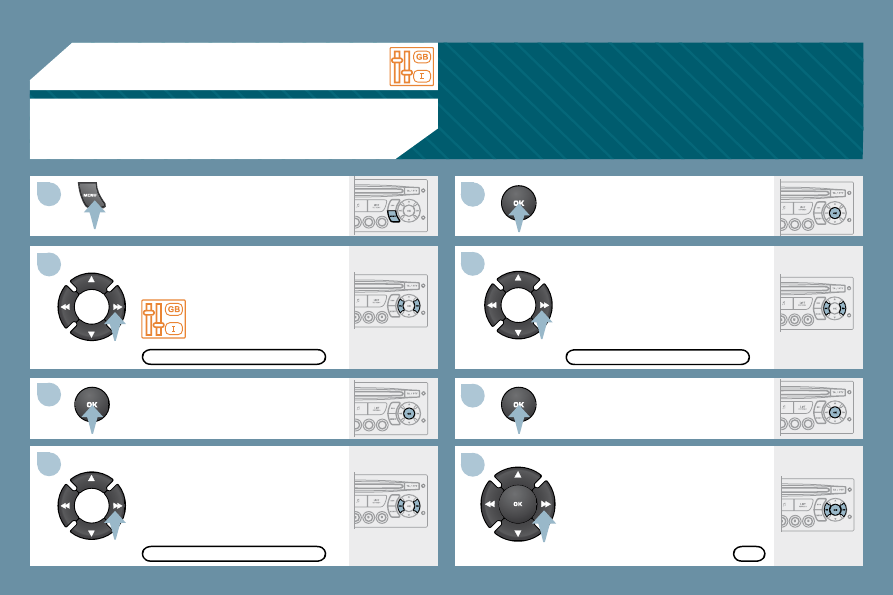
215
11
22
33
44
55
66
77
88
07 CONFIGURATION
Press the MENU button.
Using the arrows, select
PERSONALISATION
CONFIGURATION.
Press to confi rm the selection.
Using the arrows, select DISPLAY
CONFIGURATION.
Press to confi rm the selection.
Press to confi rm the selection.
Using the arrows, select ADJUST
DATE AND TIME.
Adjust the settings one by one
confi rming by pressing the OK button.
Next select the OK tab on the screen
then confi rm.
DISPLAY CONFIGURATION.
ADJUST DATE AND TIME
OK
PERSONNALISATION CONFIGURATION
SETTING THE DATE AND TIME
SCREEN C

216
9
08
Each press of the button, located at the end of the
wiper stalk , displays the different trip computer
information in succession, depending on the screen.
- the "vehicle " tab with:
the range, the current fuel consumption and the distance remaining to
the destination,
- the "1" tab (trip 1) with:
the average speed, the average consumption and the distance travelled
calculated over trip "1",
- the "2" tab (trip 2) with the same information for a second trip.
A FEW DEFINITIONS
Range: displays the distance which can travelled with the remaining fuel
detected in the tank, based on the average fuel consumption over the last
few miles (kilometres).
This displayed value may vary signifi cantly following a change in the
vehicle speed or the relief of the route.
When the range falls below 20 miles (30 km), dashes are displayed. After
fi lling with at least 5 litres of fuel, the range is recalculated and is displayed
when it exceeds 60 miles (100 km).
If, whilst driving, dashes are displayed continuously in place of the digits,
contact a PEUGEOT dealer.
Current fuel consumption: only calculated and displayed above 20 mph
(30 km/h).
Average fuel consumption: this is the average fuel consumption since
the last trip computer zero reset.
Distance travelled: calculated since the last trip computer zero reset.
Distance remaining to the destination: calculated with reference to
the fi nal destination, entered by the user. If guidance is activated, the
navigation system calculates it as a current value.
Average speed: this is the average speed calculated since the last trip
computer zero reset (ignition on).
Zero reset
When the required trip is displayed, press the control for more than
two seconds.
TRIP COMPUTER

217
1
2
2
2
2
1
2
2
1
2
3
3
1
2
2
2
2
2
2
1
2
2
2
2
2
2
2
2
1
2
2
1
2
3
2
3
1
1
1
1
09
1
1
1
1
RADIO-CD
DISPLAY ADJUST
YEAR
MONTH
DAY
HOUR
MINUTES
12 H/24 H MODE
SCREEN MENU MAP
MAIN FUNCTION
* The parameters vary according to vehicle.
CHOICE A
Choice A1
Choice A2
CHOICE B...
LANGUAGE
FRANCAIS
ITALIANO
NEDERLANDS
PORTUGUES
PORTUGUES-BRASIL
DEUTSCH
ENGLISH
ESPANOL
Press the OK dial for access to short-cut
menus according to the display on the
screen:
monochrome A
monochrome C
RADIO
activate/deactivate RDS
activate/deactivate REG mode
activate/deactivate radiotext
RDS SEARCH
REG MODE
CD REPEAT
RANDOM PLAY
VEHICLE CONFIG *
REV WIPE ACT
GUIDE LAMPS
OPTIONS
DIAGNOSTICS
consult
abandon
UNITS
TEMPERATURE: °CELSIUS/°FAHRENHEIT
FUEL CONSUMPTION: KM/L - L/100 - MPG
CD/MP3 CD
activate/deactivate Intro
activate/deactivate track repeat (the entire current CD for
CD, the entire current folder for MP3 CD)
activate/deactivate random play (the entire current CD for
CD, the entire current folder for MP3 CD)
USB
activate/deactivate track repeat (of the current folder/
artist/genre/playlist)
activate/deactivate random play (of the current folder/
artist/genre/playlist)
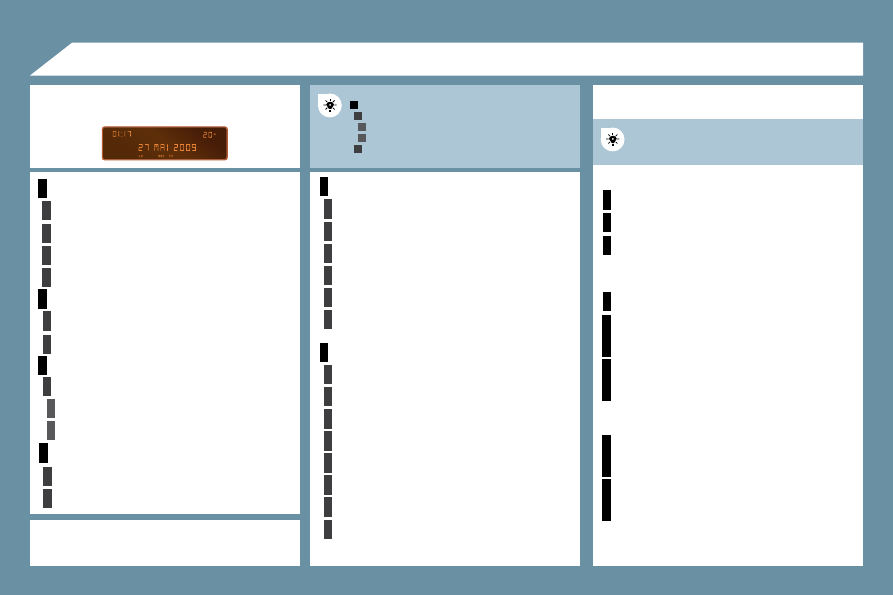
217
1
2
2
2
2
1
2
2
1
2
3
3
1
2
2
2
2
2
2
1
2
2
2
2
2
2
2
2
1
2
2
1
2
3
2
3
1
1
1
1
09
1
1
1
1
RADIO-CD
DISPLAY ADJUST
YEAR
MONTH
DAY
HOUR
MINUTES
12 H/24 H MODE
SCREEN MENU MAP
MAIN FUNCTION
* The parameters vary according to vehicle.
CHOICE A
Choice A1
Choice A2
CHOICE B...
LANGUAGE
FRANCAIS
ITALIANO
NEDERLANDS
PORTUGUES
PORTUGUES-BRASIL
DEUTSCH
ENGLISH
ESPANOL
Press the OK dial for access to short-cut
menus according to the display on the
screen:
monochrome A
monochrome C
RADIO
activate/deactivate RDS
activate/deactivate REG mode
activate/deactivate radiotext
RDS SEARCH
REG MODE
CD REPEAT
RANDOM PLAY
VEHICLE CONFIG *
REV WIPE ACT
GUIDE LAMPS
OPTIONS
DIAGNOSTICS
consult
abandon
UNITS
TEMPERATURE: °CELSIUS/°FAHRENHEIT
FUEL CONSUMPTION: KM/L - L/100 - MPG
CD/MP3 CD
activate/deactivate Intro
activate/deactivate track repeat (the entire current CD for
CD, the entire current folder for MP3 CD)
activate/deactivate random play (the entire current CD for
CD, the entire current folder for MP3 CD)
USB
activate/deactivate track repeat (of the current folder/
artist/genre/playlist)
activate/deactivate random play (of the current folder/
artist/genre/playlist)
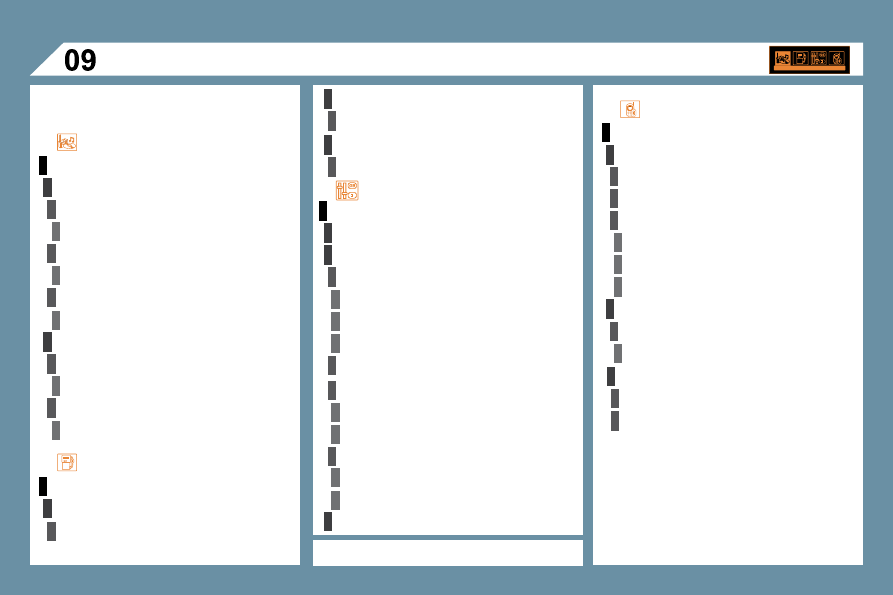
218
1
2
3
4
3
4
3
2
3
4
3
4
1
2
1
2
3
3
3
4
4
4
2
3
4
2
3
3
4
3
1
2
4
3
2
4
4
3
3
4
4
2
3
4
4
3
2
3
2
SCREEN MENU MAP
BLUETOOTH TELEPHONE
AUDIO FUNCTIONS
PLAY MODES
album repeat (RPT)
activate/deactivate
track random play (RDM)
activate/deactivate
TRIP COMPUTER
MANAGE THE TELEPHONE CALL
terminate the current call
Activate private mode
FM BAND PREFERENCES
alternative frequencies (RDS)
activate/deactivate
regional mode (REG)
activate/deactivate
radio-text information (RDTXT)
activate/deactivate
ENTER DISTANCE TO DESTINATION
Distance: x miles
BLUETOOTH CONFIGURATION
Connect/Disconnect a device
Telephone function
Audio Streaming function
Consult the paired device
Delete a paired device
Perform a Bluetooth search
CALL
Calls list
Directory
Pressing the MENU button displays:
PERSONALISATION-CONFIGURATION
DEFINE THE VEHICLE PARAMETERS *
DISPLAY CONFIGURATION
video brightness adjustment
normal video
inverse video
brightness (- +) adjustment
date and time adjustment
day/month/year adjustment
hour/minute adjustment
choice of 12 h/24 h mode
choice of units
l/100 km - mpg - km/l
°Celsius/°Fahrenheit
* The parameters vary according to vehicle.
CHOICE OF LANGUAGE
ALERT LOG
Diagnostic s
STATUS OF THE FUNCTIONS *
Functions activated or deactivated
monochrome C
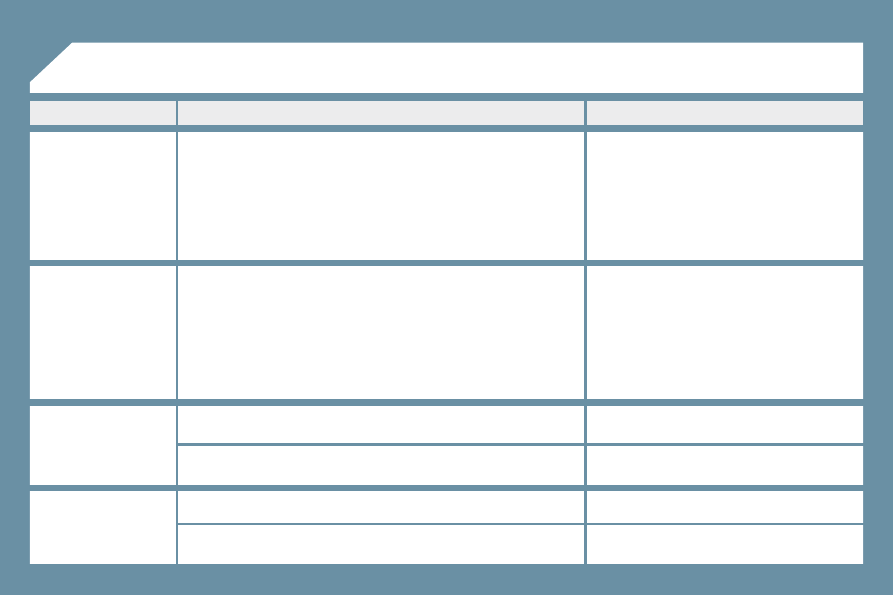
219
There is a difference in
sound quality between
the different audio
sources (radio, CD...).
Check that the audio settings (Volume, Bass,
Treble, Ambience, Loudness) are adapted to
the sources listened to. It is advisable to set
the AUDIO functions (Bass, Treble, Front-Rear
Balance, Left-Right Balance) to the middle
position, select the musical ambience "None"
and set the loudness correction to the "Active"
position in CD mode or to the "Inactive" position
in radio mode.
For optimum sound quality, the audio settings (Volume, Bass, Treble,
Ambience, Loudness) can be adapted to the different sound sources,
which may result in audible differences when changing source (radio,
CD...).
The CD is ejected
automatically or is not
played by the player.
- Check that the CD is inserted in the player the
right way up.
- Check the condition of the CD: the CD cannot
be played if it is too damaged.
- Check the content in the case of a recorded
CD: consult the advice in the "Audio" section.
- The audio equipment's CD player does not
play DVDs.
- Due to their quality level, certain writeable CDs
will not be played by the audio system.
The CD is inserted upside down, is unplayable, does not contain any audio
data or contains an audio format which the player cannot play.
The CD is protected by an anti-pirating protection system which is not
recognised by the audio equipment.
The message "USB
peripheral error" is
displayed on the screen.
Recharge the battery of the peripheral device.
The Bluetooth connection is cut.
The battery of the peripheral may not be suffi ciently charged.
The USB memory stick is not recognised.
The memory stick may be corrupt.
Reformat the memory stick.
QUESTION
SOLUTION
ANSWER
FREQUENTLY ASKED QUESTIONS
The CD player sound
is poor.
The CD used is scratched or of poor quality.
Insert good quality CDs and store them in
suitable conditions.
The audio equipment settings (bass, treble, ambiences) are unsuitable.
Set the treble or bass level to 0, without selecting
an ambience.
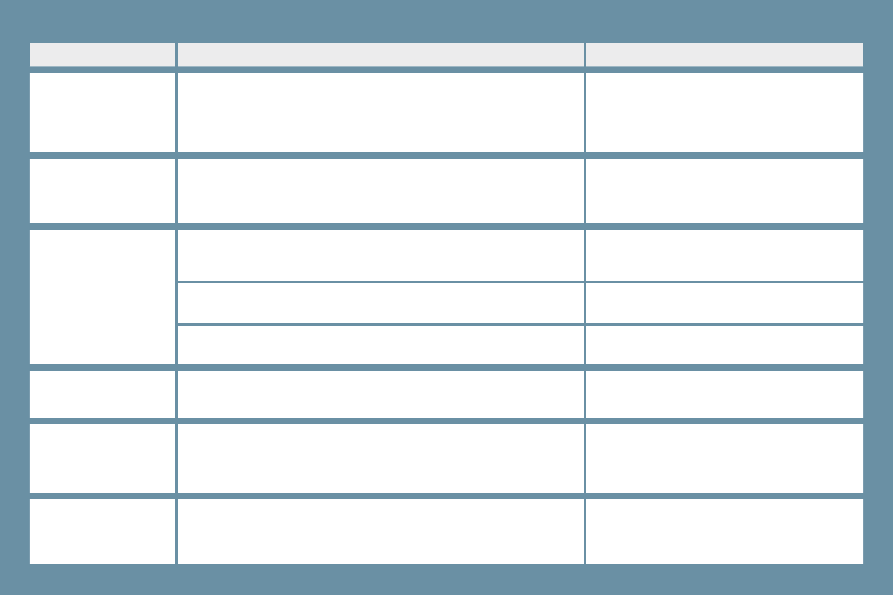
220
The traffi c announcement
(TA) is displayed. I do
not receive any traffi c
information.
Tune to a radio station which broadcasts traffi c
information.
The radio station is not part of the regional traffi c information network.
QUESTION
SOLUTION
ANSWER
The quality of reception
of the radio station
listened to gradually
deteriorates or the
stored stations do
not function (no
sound, 87.5 Mhz is
displayed...).
The vehicle is too far from the transmitter used by the station listened to or
there is no transmitter in the geographical area through which the vehicle
is travelling.
The environment (hills, buildings, tunnels, basement car parks...) block
reception, including in RDS mode.
The aerial is absent or has been damaged (for example when going
through a car wash or into an underground car park).
Activate the RDS function to enable the system
to check whether there is a more powerful
transmitter in the geographical area.
This phenomenon is normal and does not
indicate a failure of the audio equipment.
Have the aerial checked by a PEUGEOT dealer.
Sound cut-outs of
1 to 2 seconds in radio
mode.
During this brief sound cut-out, the RDS searches for any frequency
permitting better reception of the station.
Deactivate the RDS function if the phenomenon
is too frequent and always on the same route.
With the engine off,
the audio equipment
switches off after a few
minutes of use.
When the engine is switched off, the audio equipment operating time
depends on the battery charge.
The switch-off is normal: the audio equipment switches to economy mode
and switches off to prevent discharging of the vehicle's battery.
Start the vehicle's engine to increase the battery
charge.
The stored stations do
not function (no sound,
87.5 Mhz is displayed...).
An incorrect waveband is selected.
Press the BAND AST button to return to the
waveband (AM, FM1, FM2, FMAST) on which the
stations are stored.
The message "the audio
system is overheated"
appears on the display.
Switch the audio system off for a few minutes to
allow the system to cool.
In order to protect the installation if the surrounding temperature is too
high, the audio equipment switches to an automatic thermal protection
mode leading to a reduction of the volume or stopping of the playing of the
CD.
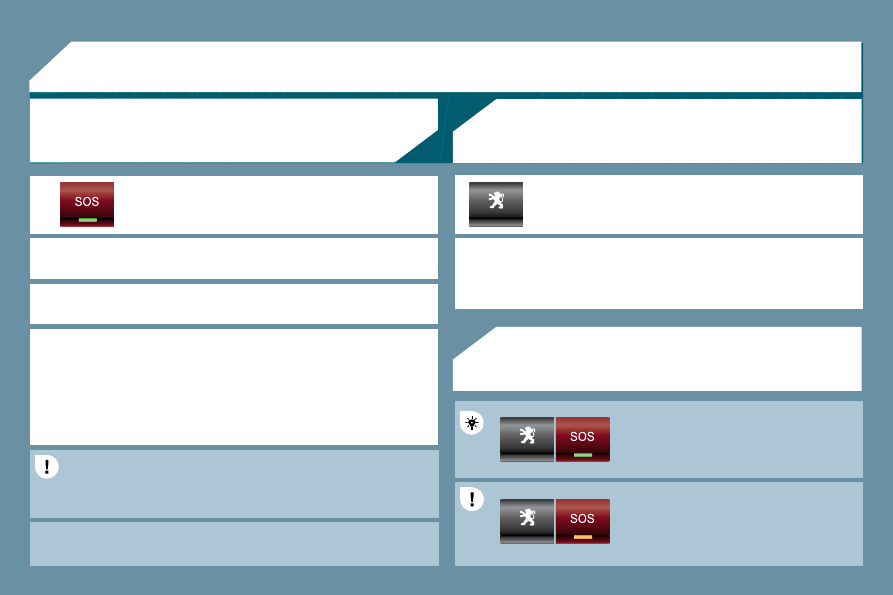
221
EMERGENCY OR ASSISTANCE CALL
EMERGENCY CALL
ASSISTANCE CALL
OPERATION OF THE SYSTEM
In an emergency, press this button for more than
2 seconds. Flashing of the green diode and a voice
message confi rm that the call has been made to the
PEUGEOT Emergency team * .
Pressing this button again immediately cancels the request. The green
diode switches off.
The green diode remains on (without fl ashing) when communication is
established. It switches off at the end of communication.
This call is dealt with by the PEUGEOT Emergency team which receives
locating information from the vehicle and can send a detailed alert to the
appropriate emergency services. In countries in which the team is not
operational, or when the locating service has been expressly refused,
the call is dealt with directly by the emergency services (112) without the
vehicle location.
If an impact is detected by the airbag ECU, and independently of any
triggering of the airbags, an emergency call is made automatically.
* This service is subject to conditions and availability.
Consult a PEUGEOT dealer.
Press this button for more than 2 seconds to request
assistance if the vehicle breaks down.
A voice message confi rms that the call has been made * .
Pressing this button again immediately cancels the request.
The cancellation is confi rmed by a voice message.
When the ignition is switched on, the green
indicator lamp comes on for 3 seconds
indicating that the system is operating
correctly.
If the orange indicator lamp fl ashes: there is
a system malfunction.
If the orange indicator lamp is lit continuously:
the backup battery must be replaced.
In both cases, consult a PEUGEOT dealer.
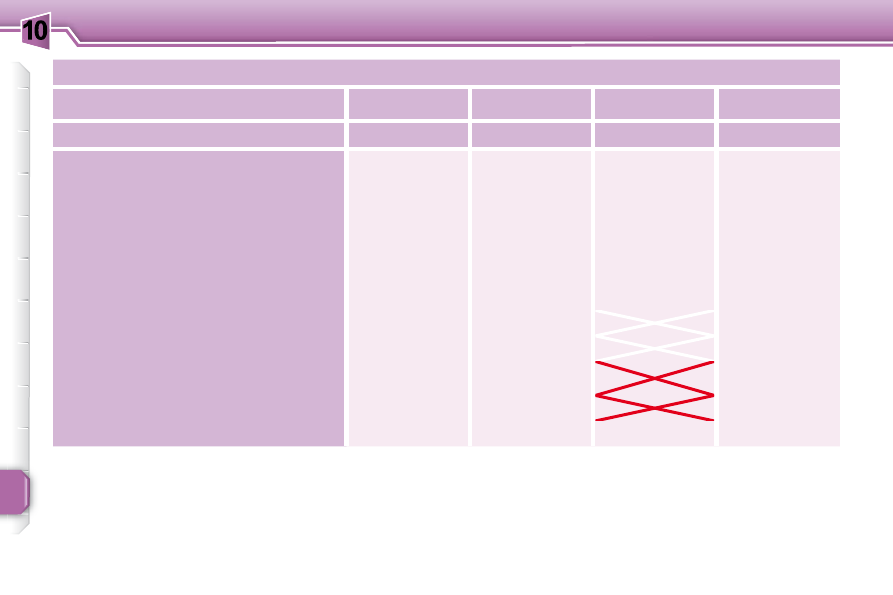
10
168
TECHNICAL DATA
SALOON WEIGHTS AND TOWED LOADS (in kg)
Diesel engines
1.4 litre Turbo
HDI 70 hp
1.6 litre Turbo
HDI 90 hp
1.6 litre Turbo HDI
90 hp 99g
1.6 litre Turbo
HDI 110 hp
Gearboxes
Manual
Manual
Manual
Manual
-
Kerb weight
1 261 - 1 251 - 1 269 1 280 - 1 272 - 1 290
1 260 - 1 279
1 328 - 1 319 - 1 358
-
Payload
399 - 369 - 341
420 - 408 - 340
445 - 450
382 - 391 - 323
-
Gross vehicle weight (GVW)
1 660 - 1 620 - 1 610 1 700 - 1 680 - 1 630
1 630 - 1 654
1 710 - 1 710 - 1 681
-
Gross train weight (GTW)
on a 12 % gradient
2 242 - 2 265
2 650
1 630 - 1654
2 690
-
Braked trailer (within GTW limit)
on a 10 % or 12 % gradient
600
950 - 970 - 1 020
980
on an 8 % gradient
-
980 - 1 000
1 030
-
Braked trailer ** (with load transfer within
GTW limit)
850
1 150
1 150
-
Unbraked trailer
600
600
600
-
Recommended nose weight
46
46
46
46
The GTW and towed load values indicated apply up to a maximum altitude of 1 000 metres; the towed load mentioned must
be reduced by 10 % for each additional 1 000 metres of altitude.
The speed of a towing vehicle must not exceed 60 mph (100 km/h) (comply with the legislation in force in your country).
High ambient temperatures may result in a reduction in the performance of the vehicle in order to protect the engine; when
the ambient temperature is higher than 37 °C, limit the weight towed.
** The weight of the braked trailer may be increased, within the GTW limit, on condition that the GVW of the towing vehicle is reduced
by the same amount; warning, towing using a lightly loaded towing vehicle may adversely affect its roadholding performance.

Нет комментариевНе стесняйтесь поделиться с нами вашим ценным мнением.
Текст